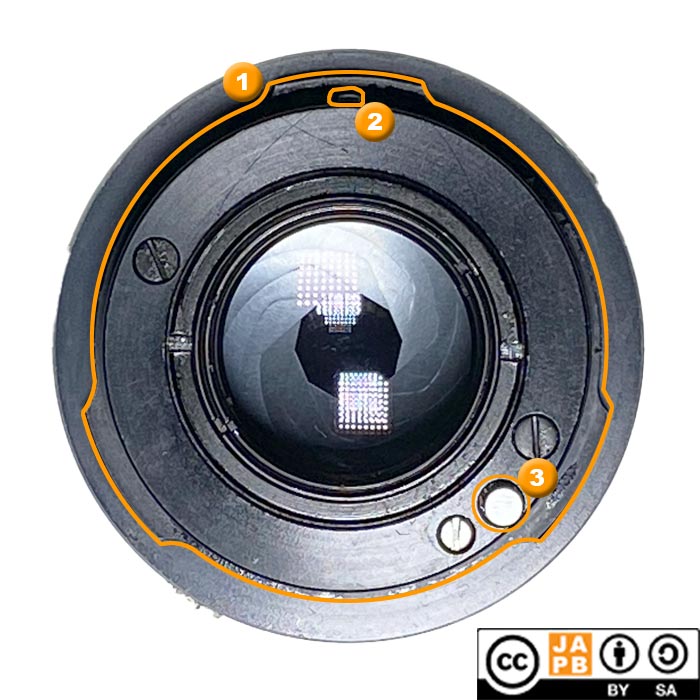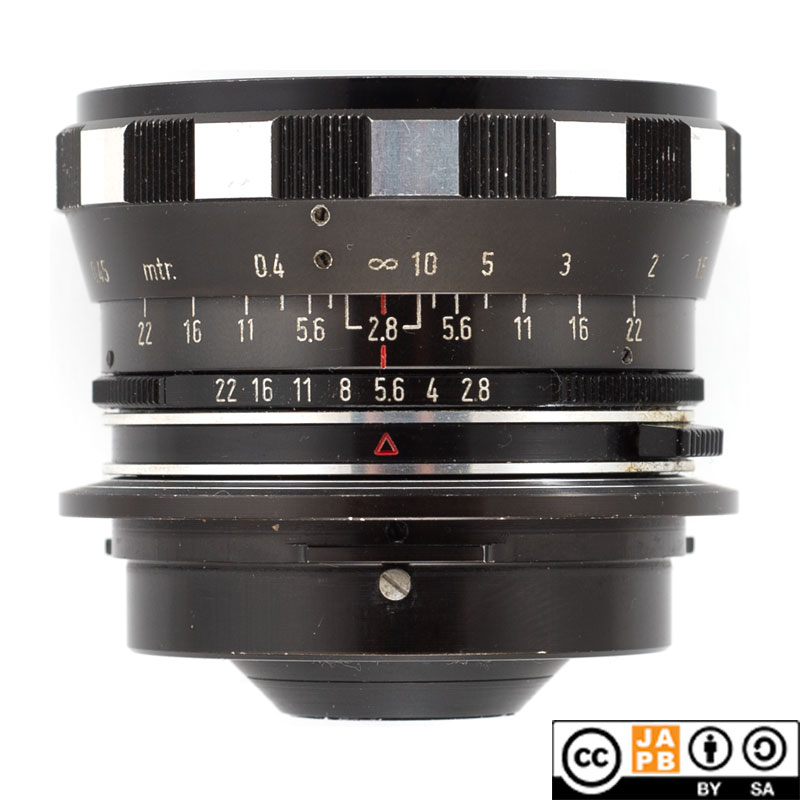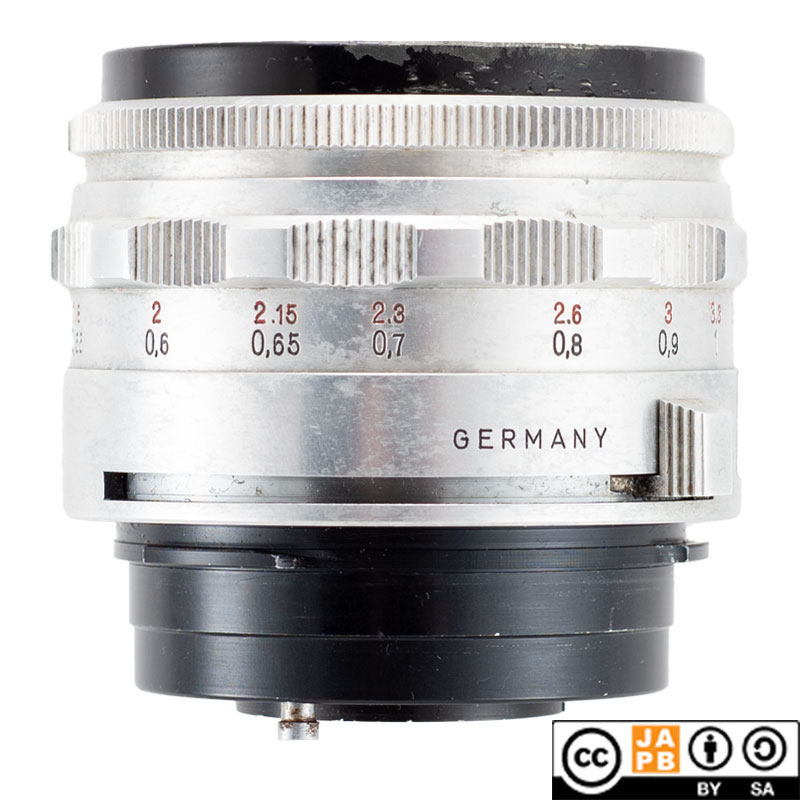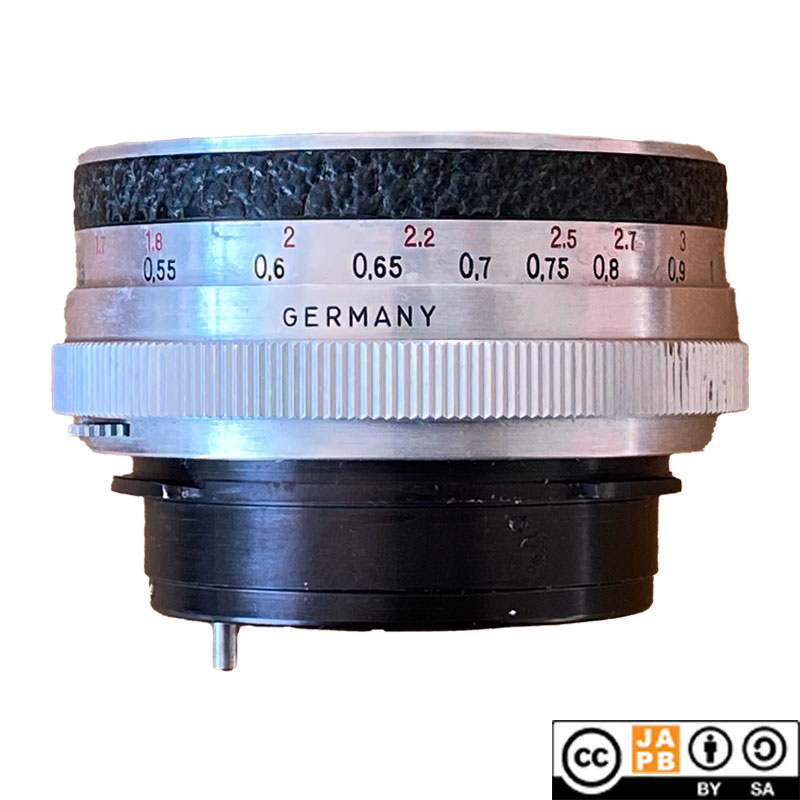Pekka Buttler (Updated 09/2024)
No, there’s no typo in the heading or title. This article is really about the PraktiNa mount (not PraktiCa). The Praktina was a revolutionary camera of East German design, introduced by KW (Kamera-Werkstätten) in 1952 and manufactured 1953–1960.

Praktina mount specifications and identification
Mount type: Breech-lock (ring on camera)
Flange focal distance: 50 mm
Film format: 36mm x 24mm (‘Full frame’)
Mount communication: aperture stop-down (camera-to-lens)

Key characteristics of the mount of Praktina-mount lenses
[1] Orientation pin at 12:00 (on a camera, this always goes up)
[2] Breech-lock mount with three lugs
[3] Aperture manipulation1 pin (manual and preset lenses will not have this).
The Praktina mount is a breech-lock mount, where the breech-lock’s friction ring is on the camera’s end, meaning that (when only looking at a lens) one might mistake it for a bayonet mount.
Note please, that the Praktina mount has identical characteristics with the Pentacon Six mount, but as the Pentacon Six mount is for a medium format camera, the Pentacon Six mount is significantly larger than that of regular 135-format film cameras.
Basic Information on the Praktina mount:
Many credit the Praktina FX with being the first true system camera, as it was from the onset designed to be extremely modular: Not only could you you switch lenses, but focusing screens, viewfinders, and even camera backs were interchangeable. In combination with also offering a winder coupling, a proprietary mount that facilitated wide open metering and auto aperture, and a host of other advanced features The Praktina FX was able to lay a claim to being the most advanced and versatile camera system of its age.
Moreover, the Praktina camera (and its mount) was supported by a wide spectrum of European lens manufacturers, including Carl Zeiss Jena, Meyer-Optik Görlitz, Angénieux, Enna, ISCO, Kilfitt, Schacht, Schneider-Kreuznach, Steinheil (and a number of less known manufacturers). As a result, The Praktina system was able to claim that it not only offered an advanced camera and a wide spectrum of advanced accessories (those that make an interchangeable lens camera into a system camera), but also a full range (24–1000 mm) of world-class lenses.
Praktina mount developments
The Praktina mount (1952-1960) coincided with a watershed moment in enthusiast photography: the advent of auto aperture.
More precisely, and specifically for the case of the Praktina system, this meant that a wide range of aperture mechanisms were on offer.
Manual and preset aperture
Manual aperture simply means that the photographer controls the aperture entirely manually, and any aperture value selected on the aperture ring directly modifies the opening (aperture) of the diaphragm mechanism. In manual aperture lenses, there are two fundamental approaches: with stop-clicks and without stop-clicks.
Manual aperture – while entirely feasible in viewfinders and rangefinders (where you do not look through the lens) is decidedly tricky on SLRs, because you would always need to open the lens up for framing and focusing, and then close down the lens for taking the shot. In the worst case, you would need to remove your eye from the SLRs viewfinder to be able to see which aperture value you select, only to then need to check your framing while barely being able to see anything through the now stopped down lens. Granted, having aperture click stops helped here, because if you did your math, you could count the clicks without needing to move your camera from your eye, but this still was a decidedly troublesome approach.
Preset aperture tried to simplify this by allowing the photographer to set their desired aperture in advance (pre-setting it). In practical terms, pre-set apertures would act to limit the smallest aperture value the lens could be stopped down to. Before taking the shot the photographer would open the aperture all the way up, frame and focus the shot, and then with one swift movement rotate the aperture ring as far as it went (to its pre-set aperture)

Up until the early 1950s it had been more than enough to offer photographers the chance to use either a fully manual aperture ring, or a preset aperture mechanism. Now it seemed obvious that there was a crucial and error-prone step between a) framing and focusing wide open; and b) stopping down the aperture for taking a shot. And that this step could be avoided with some well-considered automation.
The first step was semi-automatic apertures. These would all be based on the idea that lenses would have a lever that the photographer would use (after having taken one shot), to open up the aperture and prime it for the next shot. In essence, semi-automatic meant that: The photographer would manually open the aperture; the camera would automatically stop it down.
While this sounds horribly complicated and work-intensive by today’s standards, you should remember that back then also mirrors would stay in the upright position after a shot, and you would have to cock the shutter for the mirror to go back down. In that sense, having to manually open the aperture was just one of those steps you had to do to get your camera ready for the next shot.

While many camera and lens manufacturers managed to jump over the semi-automatic phase (and progressed directly from manual/preset to full auto), the Praktina FX was by no means the only camera to use semi-automatic aperture lenses. Very prominently, also Asahi (Pentax) used semi-automatic apertures on its early Auto-Takumar lenses, as did Topcon on Auto-Topcor lenses.
In any case, the first generation of Praktina cameras (the Praktina FX, 1952–1958)) and lenses were based on semi-automatic operation. In this mode, a slight pressure on the aperture stop-down pin (see mount illustration above) will trigger the lens to stop-down to its selected aperture with a satisfying clunk.
Automatic aperture
By the time KW was ready to introduce the second iteration of the Praktina (1958, the Praktina IIa) it had become obvious that semi-auto was a stopgap at best. Instead, lenses would now be fitted with a spring that would always try to pull the lens’ aperture closed to whatever setting the photographer had dialed in on the lens’ aperture ring, and that the pin that had previously been used to trigger the stopping down of the aperture would instead be used to hold the lens’ aperture open.

Compatibility issues
Going from the FX-model to the IIa-model, Praktina cameras switched their approach to what the aperture pin on its lenses does.
In case of the Praktina FX (and semi-automatic lenses) pushing the lens’ aperture pin lead to the triggering of closing down mechanism. In the case of the Praktina IIa the lens’ aperture pin suddenly needed to be depressed by the camera all the time to keep the aperture open and as soon as the camera would release the pin, the aperture would close down. This change in approach lead to that Praktina FX bodies and later Praktina auto lenses were not compatible, nor would all Praktina IIa bodies necessarily work with with the previous Semi-auto lenses2. 🤷🏼
End of the Praktinas
So if the Praktina system was so groundbreaking, why was it abandoned only after 7 years in production? The reasons most often cited are:
a) the proprietary mount meant that competing mounts (especially M42) had a wider ecosystem of lenses, combined with that KW was simultaneously producing M42-cameras (Prakticas);
b) high production costs due to the sophisticated design;
c) disappointing sales (less than 100 000 cameras in 7 years) and, moreover, low demand for the sophisticated accessories;
d) increasing competition from Japanese SLR’s;
e) that the Praktina was not really abandoned, merely the name and the mount. According to this explanation the Prakticas caught up with the Praktinas and KW merely streamlined their product portfolio.
And these are likely all true (both separately and in combination).
Side note: When KW in 1956 decided to develop a medium format, interchangeable lens SLR (the Praktisix, later renamed to Pentacon Six), KW felt the Praktina mount offered everything this new medium format needed – except the requisite size. The Praktisix therefore adopted an upscaled version of the Praktina mount. I kid you not: the mounts are basically identical except that the Pentacon Six mount is bigger in all respects. While KW decided to abandon the Praktina system in 1960, the Praktina mount lived on in the form of the Pentacon Six mount for almost three more decades.
Adapting Praktina lenses
First, why would you want to adapt Praktina lenses? Notwithstanding the situation wherein you’re already in possession of a wide spectrum of quality Praktina lenses, well… A majority of those lenses that were available for the Praktina mount were also available for Exakta and M42 mounts. So, in a way, there are few ‘unicorns’ that would make investing in the Praktina mount (and adapters) especially attractive. On the other hand, one might well encounter the situation where a particular legendary late-50’s lens (e.g. Biotar 75/1.5; Flektogon 25/4; Trioplan 100/2.8) could be most affordable in Praktina mount…
Problematically, Praktina mount adapters are not exactly 13 a dozen. In fact, they’re outright rare. I’ve (as of autumn 2024) found one specialised adapter manufacturer that offers Praktina-to–mirrorless adapters (and we’re talking intermediate three-figures prices) as well as a couple of D-I-Y manufacturers that sell their products over the typical platforms (ebay, et al.).
This is – in 2024 – outright unusual, as there are no real reasons why Praktina mount lenses could not easily and fluently be adapted to mirrorless full-frame cameras (assuming that you have an adapter).
Moreover, even though the Praktina mount technically has a generous flange focal distance, the fact that that distance is computed for a breech-lock mount that was designed to enable lenses to protrude relatively far into the mount makes it very unlikely that Praktina lenses could successfully be adapted to any SLR/dSLR mount.
Hence, unless you have a functioning, original Praktina camera, your best bet is the combination of a DIY adapter to your preferred full-frame mirrorless camera mount.
Read more:
Praktina.com by Alberto Taccheo
Also Mike Otto offers a fair bit of information on Praktinas
Footnotes
- There’s a reason that i cryptically call this the aperture manipulation pin. Read on ↩︎
- There are two subtypes of the Praktina IIa. The earlier (vastly more common) subtype is incompatible with all semi-automatic aperture lenses. The later subtype can use Semi-automatic lenses if they are mounted offset by 120 ° (the later subtype of the IIa would allow mounting of lenses in two orientations and the secondary orientation would offer compatibility with the semi-automatic lenses). ↩︎